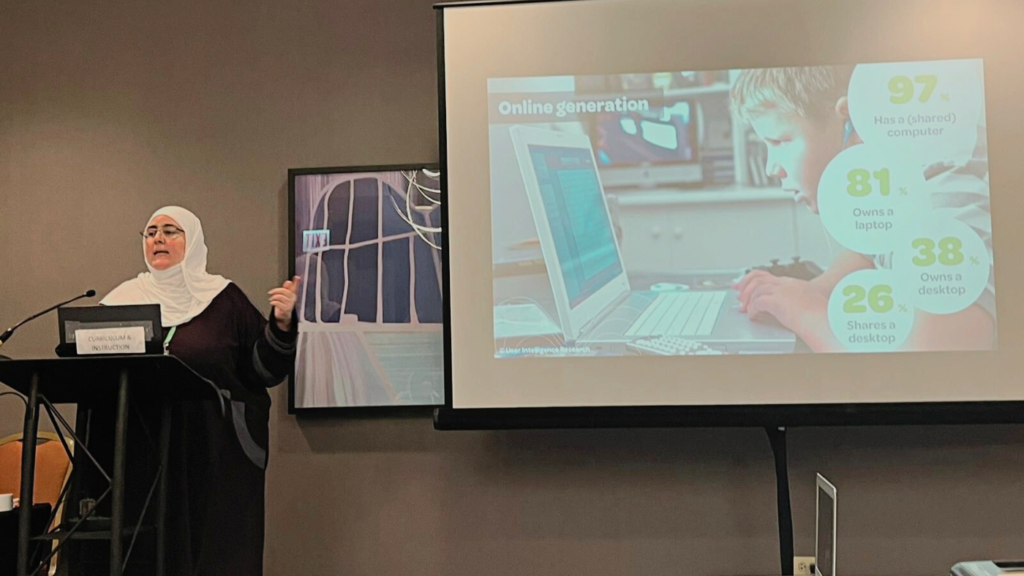This weekend I had the pleasure of attending the ISNA Education Conference in Chicago. It was an eye-opening experience to meet all the Islamic school leaders and teachers who attended, and to hear about the amount of work they are doing and their efforts to provide a solid education and safe spaces for Muslim youth around the United States. My contribution was a presentation about integrating technology into education. My belief is that this is not only a cool, fun, and effective way to learn, but also a necessary addition to our curricula.
Today’s youth are for the most part digital natives. A digital native is someone who grew up familiar with computers and the internet from a young age[1]. There are a range of ways in which digital natives tend to experience the world differently, from processing information to buying & selling, to interacting socially. As such, they have different needsto make learning experiences meaningful to them.[2]For one, digital natives are more likely to prefer multitasking, so expecting them to focus on only one thing at a time can be limiting to their abilities and creativity. Secondly, they are accustomed to having the world at their fingertips. Similarly, in the classroom, they need to have all the resources, files and information they need readily available to them so that they can interact fully with the material. Third, they prefer simple, intuitive processes which they can figure out on their own. This grants them a greater sense of autonomy and leads to more productivity. By adjusting our teaching methods and adding a touch of technology and fun, our young students can feel more ownership, autonomy, and flexibility in their spaces of learning.
It is also important to include technology in the education of digital natives because computers and the online world is the space where they feel most comfortable and confident. According to Gardner’s theory of multiple intelligences, students learn best when they can use their strengths in the learning process. Since today’s students are “digitally intelligent”, then it follows that digital learning would be more beneficial to them so they can learn faster, better, and more long term, regardless of the subject they are learning.
Utilizing technology also means that we as educators are able to come into our students’ world, ensure they are navigating it safely, and know how to conduct themselves in it. Just as we would not send our youth unattended into a new library, playground, community center, or school without first exploring it and ensuring it is safe, we cannot send them into the online world on their own. By utilizing technology for learning, we are able toaccompany them into this world, monitor and guide them as they experience it, and ensure that they know how to behave when they are there. Whether they are posting on social media, sending an email, or creating an online persona, the responsibility lays on the shoulders of educators and parents to ensure that they are conducting themselves correctly and safeguarding them from the dangers and risks of being in this world.
Finally, by integrating technology into education, we are preparing our youth for the future, a future that is only moving more and more towards being a fully digital age. The world they will live in as they become adults looks and operates very differently from the one we live in today. From communication to buying & selling to travel, digital skills will be essential to many spheres of life in the future.
As part of this presentation, I conducted a survey of Muslim parents to gauge their children’s use of technology and comfort level. Out of 125 respondents, 85% reported that their children are proficient using technology, with little or no support from adults. This was for children ages 8-12 only. This shows a clear trend that Muslim children are indeed by and large digital natives and are experiencing the world differently than their parents and teachers. There are many considerations to keep in mind, such as cost, balance of on-screen versus off-screen time, and the training and resources needed for adults and educational institutions to get up to speed with digital advancements. And admittedly there are many risks and negative effects of technology, but this is a wave that is increasing in reach and magnitude, and one that we will not be able to avoid. Rather, I propose that we learn to ride the wave, prepare our students for it, and use it for thebenefit of our children and their future.
EamaanRabbat
Education Director
Rabata
[1]Prensky, Mark. “Digital Natives, Digital Immigrants.” MCB University Press 9.5 (2001): 1-6. Web. 14 October 2012.
[2]Schippers, Saskia, and MeikeMak. “Creating Outstanding Experiences for Digital Natives.” UXMagazine. July 24, 2014.



